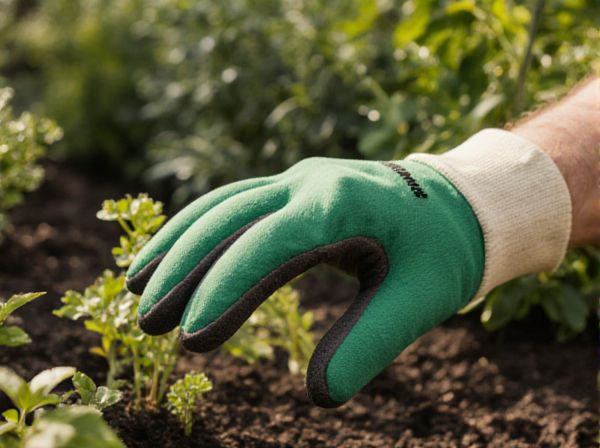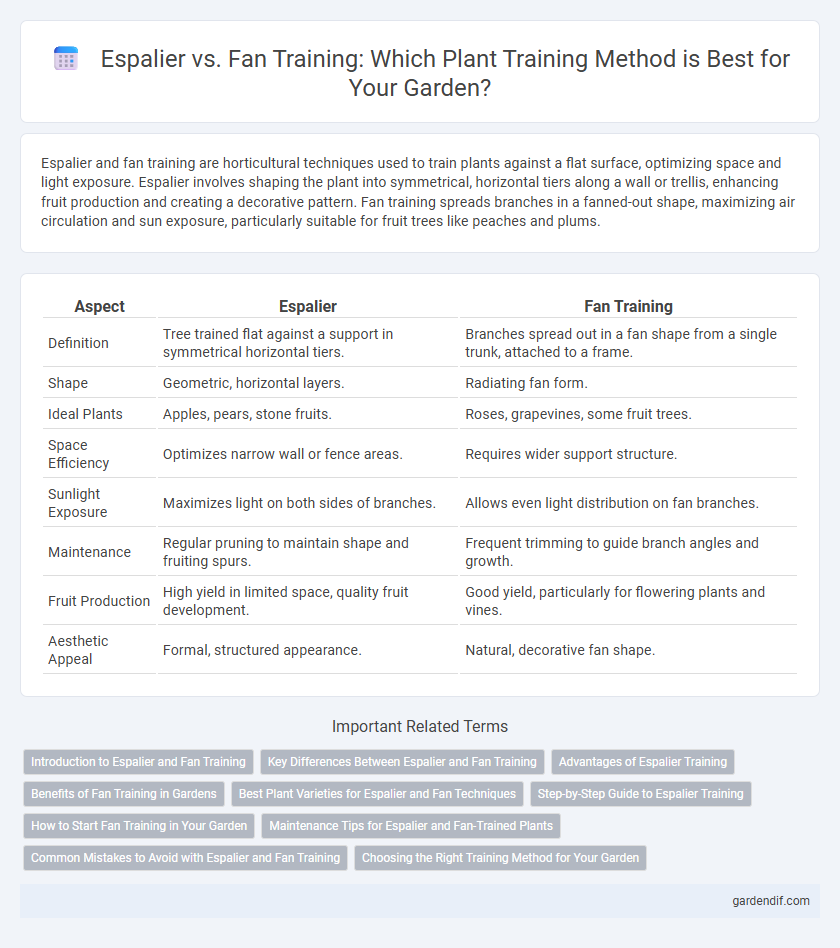
Espalier vs Fan Training Illustration
Espalier and fan training are horticultural techniques used to train plants against a flat surface, optimizing space and light exposure. Espalier involves shaping the plant into symmetrical, horizontal tiers along a wall or trellis, enhancing fruit production and creating a decorative pattern. Fan training spreads branches in a fanned-out shape, maximizing air circulation and sun exposure, particularly suitable for fruit trees like peaches and plums.
Table of Comparison
| Aspect | Espalier | Fan Training |
|---|---|---|
| Definition | Tree trained flat against a support in symmetrical horizontal tiers. | Branches spread out in a fan shape from a single trunk, attached to a frame. |
| Shape | Geometric, horizontal layers. | Radiating fan form. |
| Ideal Plants | Apples, pears, stone fruits. | Roses, grapevines, some fruit trees. |
| Space Efficiency | Optimizes narrow wall or fence areas. | Requires wider support structure. |
| Sunlight Exposure | Maximizes light on both sides of branches. | Allows even light distribution on fan branches. |
| Maintenance | Regular pruning to maintain shape and fruiting spurs. | Frequent trimming to guide branch angles and growth. |
| Fruit Production | High yield in limited space, quality fruit development. | Good yield, particularly for flowering plants and vines. |
| Aesthetic Appeal | Formal, structured appearance. | Natural, decorative fan shape. |
Introduction to Espalier and Fan Training
Espalier is a horticultural technique that trains trees to grow flat against a support, creating a two-dimensional framework ideal for space-saving and decorative purposes. Fan training guides branches outward in a fan shape from a central trunk, optimizing sunlight exposure and air circulation, often used for fruit trees against walls. Both methods enhance fruit production and accessibility while adding architectural interest to gardens.
Key Differences Between Espalier and Fan Training
Espalier training involves guiding a plant's branches along a flat, two-dimensional framework, often against a wall or fence, optimizing space and sunlight exposure. Fan training shapes the plant with multiple main branches radiating outward like a fan, promoting air circulation and ease of maintenance. The primary difference lies in the structural form: espalier creates a formal, linear pattern while fan training develops an open, radial arrangement.
Advantages of Espalier Training
Espalier training maximizes space efficiency by guiding plants to grow flat against walls or fences, which improves sun exposure and air circulation. This method enhances fruit production through better light distribution and easier pest control compared to fan training. Espalier also offers aesthetic appeal by creating structured, decorative shapes that complement garden design.
Benefits of Fan Training in Gardens
Fan training enhances air circulation and sunlight exposure, reducing fungal diseases and promoting healthier plant growth. It allows for efficient use of garden space by guiding branches outward in a fanned shape, making harvesting and maintenance easier. Compared to espalier, fan training offers greater flexibility for various plant species and adapts well to irregular garden walls or fences.
Best Plant Varieties for Espalier and Fan Techniques
Apple, pear, and cherry trees are among the best plant varieties for espalier and fan training techniques due to their flexible branches and manageable growth patterns. Espalier thrives with fruit trees like apples (Malus domestica) and pears (Pyrus communis), which respond well to pruning and can be shaped against walls or fences. Fan training suits espaliered fruit trees as well, especially stone fruits, enabling optimal light exposure and air circulation for enhanced fruit production.
Step-by-Step Guide to Espalier Training
Espalier training involves carefully pruning and tying branches to a flat framework against a wall or trellis, promoting controlled growth and maximizing sunlight exposure for fruit trees. The step-by-step guide includes selecting a suitable plant, establishing a sturdy support structure, pruning the central leader, and gradually tying young shoots to horizontal wires to create the desired horizontal tiers. Regular maintenance through trimming and adjustments ensures the espalier maintains its shape and encourages healthy fruit production.
How to Start Fan Training in Your Garden
To start fan training in your garden, select healthy young shoots from your plant and prune the main stem to encourage lateral branches. Secure these branches to a fan-shaped support structure using soft ties, spacing them evenly to promote optimal air circulation and light exposure. Regularly trim new growth to maintain the shape and ensure the plant develops a strong, open framework.
Maintenance Tips for Espalier and Fan-Trained Plants
Espalier maintenance requires regular pruning to maintain its flat, two-dimensional structure and promote fruit production, with emphasis on removing shoots that grow inward or disrupt the framework. Fan-trained plants need consistent trimming of side branches to sustain their open, radial growth pattern and improve air circulation, reducing disease risk. Both methods benefit from seasonal inspections to adjust ties and supports, ensuring healthy growth and structural integrity.
Common Mistakes to Avoid with Espalier and Fan Training
Common mistakes to avoid with espalier and fan training include improper pruning that disrupts the desired shape, inadequate support structures leading to weak branches, and neglecting to regularly monitor for pests and diseases that can damage the plant framework. Overcrowding branches reduces air circulation and sunlight exposure, increasing the risk of fungal infections and poor fruit development. Consistent training and maintenance tailored to each technique ensure healthy growth and optimal fruit production.
Choosing the Right Training Method for Your Garden
Espalier training shapes plants flat against a wall or trellis, maximizing space and enhancing fruit production in limited garden areas. Fan training spreads branches outward in a semi-circular pattern, ideal for air circulation and light exposure in wider garden beds. Selecting the right method depends on garden layout, plant species, and desired aesthetic, with espalier suited for compact spaces and fan training preferred for open environments.
Espalier vs Fan Training Infographic

 gardendif.com
gardendif.com